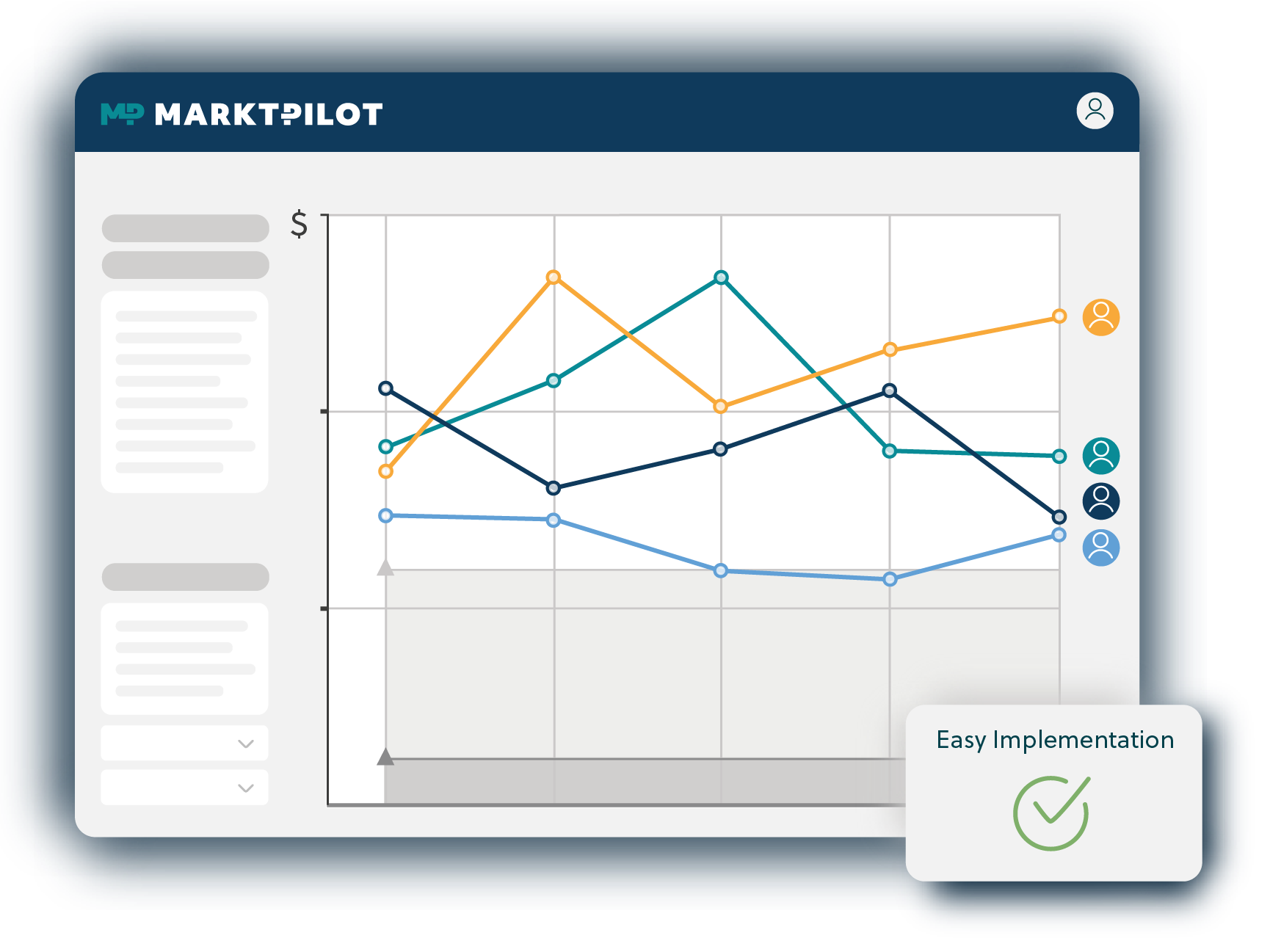Back to Growth: Smart Pricing Strategies to Boost Aftermarket Business
Transform your aftermarket strategy. Discover AI-driven pricing tactics and actionable insights from our expert-led webinar.
Effective manufacturing pricing strategies are key to boosting revenue, enhancing customer loyalty, and staying competitive. This whitepaper explores essential pricing models, their pros and cons, and how to choose the right strategy for your business.
01 What is a Pricing Strategy?
02 How to Define a Strong Manufacturing Pricing Strategy
03 Factors Influencing Pricing Decisions
04 Strong Understanding of the Market
05 An Overview of the Primary Pricing Strategies
06 Case Studies of Successful Pricing Strategies
Pricing strategy refers to the method a company uses to set the prices of its products or services. For OEMs and machine manufacturers, this involves considering numerous factors such as production costs, market demand, competition, and perceived value. It's a comprehensive approach that goes beyond mere cost-plus pricing, considering the intricacies of the market and the unique challenges faced by manufacturers.
This page will guide you through the fundamental aspects of pricing strategies, from defining what they are to exploring different kinds of pricing strategies and their respective advantages and disadvantages. Additionally, we will go further into the key performance indicators (KPIs) for assessing pricing strategies and examine the factors influencing pricing decisions.
You can find a comprehensive overview of the most common pricing strategies here.

Market Research: Analyzing competitors, customer preferences, and market dynamics provides critical insights into pricing elasticity and the perceived value of your offering.
Cost and Profit Margin Clarity: Understanding your cost structure allows for informed decisions on pricing levels that ensure profitability without compromising competitiveness.
Customer Segmentation: Tailoring pricing based on different customer segments allows for maximizing revenue by offering value propositions that resonate with specific groups.
Ongoing Monitoring and Flexibility: Markets evolve, and so should pricing strategies. Regularly assessing performance metrics and customer feedback enables timely adjustments to maintain a competitive edge and maximize profitability over time.
Profit Margins:
Monitoring gross and net profit margins helps assess the overall profitability of pricing strategies.
Price Elasticity:
Understanding how sensitive customer demand is to price changes is critical.
Customer Acquisition Cost:
CAC refers to the costs of acquiring each new customer.
Customer Lifetime Value:
CLV measures the total value or revenue a customer brings over the course of their entire business relationship with the company.
Conversion Rates:
The conversion rate describes the ratio of all prospects who achieve a specific, predefined goal.
Competitive Benchmarking:
Monitoring pricing compared to competitors provides insights into market positioning.
Market Share:
Assessing changes in market share relative to pricing adjustments helps evaluate the competitive impact of pricing strategies.
Businesses can use these KPIs to assess and refine their pricing strategies and achieve desired financial outcomes.
Several factors influence pricing decisions for machine and plant manufacturers:
Competitive Landscape: Analyzing competitors' pricing strategies and market positioning helps determine where a manufacturer stands relative to others in the industry.
Market Demand: The level of demand for the product or service influences pricing decisions.
Value Proposition: Understanding the perceived value of the product or service in the market helps in determining pricing.
Economic Conditions: Economic factors such as inflation rates, interest rates, and overall financial stability impact pricing decisions.
Distribution Channel Costs: The cost associated with delivering products to customers impacts pricing decisions.
Regulatory Environment: Compliance costs and legal requirements can influence pricing decisions.
Product Lifecycle: The stage of the product lifecycle affects pricing strategies.
By considering these factors, manufacturers can develop effective pricing strategies that balance competitiveness, profitability, and market dynamics to achieve sustainable growth and success.
A strong understanding of the market is essential for businesses to develop effective strategies and make informed decisions. This involves several key elements:
Market Segmentation: Segmenting the market based on various factors helps to identify distinct customer groups with specific needs and preferences.
SWOT Analysis: Assessing the organization's strengths, weaknesses, opportunities, and threats within the market context helps identify areas for improvement and strategic focus.
Competitor Analysis: Analyzing competitors' strengths, weaknesses, pricing strategies, and market positioning provides valuable insights.
Customer Needs and Preferences: Conducting market research to understand customer needs, pain points, preferences, and purchasing behavior enables businesses to tailor their offerings.
Market Trends and Dynamics: Understanding market trends, technological advancements, and regulatory changes enables companies to anticipate market changes.
Value Proposition: Defining your unique and compelling value proposition sets you apart from competitors.
Distribution Channels: Understanding how products or services reach customers through various channels is crucial for effective market penetration.
Market Size and Growth Potential: Evaluating the size of the market and growth projections helps businesses prioritize market segments.

The onboarding guide will provide insights on implementing market-based pricing, including the potential benefits and steps to initiate a market-based pricing strategy.
Value-based pricing sets the highest price possible based on the goods or services' worth to the customer or their perceived value. Businesses use this strategy to price their goods and services at an amount they think customers are willing to pay. Learn more about value-based pricing.


Market-based pricing involves assessing the market to set prices. This strategy helps manufacturers transform their parts business. Our research shows that when manufacturers do not use market-based pricing, they forgo revenue for an average of 73% on their purchased parts sales. Discover market-based pricing strategies.

INITIAL SITUATION
Initial Situation: At Kärcher Municipal, spare parts were previously priced using a bottom-up strategy, where the price was determined based on the cost price combined with various markup factors. This price was then tested in the market.
OBJECTIVE
For Kärcher Municipal, it is crucial to be perceived as an attractive source for spare parts and as a fairly priced partner.
SOLUTION
A joint project team from Kärcher Municipal and MARKT-PILOT is currently developing a comprehensive, market-based pricing strategy for the company.
Read more about how Kärcher Municipal has found a solution with MARKT-PILOT.
For developing a pricing strategy, tools and technologies can help by increasing efficiency and reducing errors. Implementing new technologies in business can initially be met with apprehension, especially for those who are resistant to change. However, the benefits of embracing technological advancements far outweigh the concerns.
A good pricing tool should be easy to implement and based on valid market research for spare parts. Ideally, it should collect data on prices and delivery times from both offline sources such as manufacturers and dealers, as well as from web-shops and online marketplaces. MARKT-PILOT offers a tailored solution that can be implemented in 30 minutes, provides validated results, and determines prices and delivery times for all spare parts from over 4,000 providers.
You can learn more about our products and book a demo here: Products | MARKT-PILOT

The key components of developing a pricing strategy include understanding market demand, analyzing competitor pricing, considering production costs, and evaluating customer value perception.
Different pricing strategies can significantly impact market positioning by influencing customer perception, competitive dynamics, and overall brand value.
When creating a global pricing strategy, factors such as local market conditions, cultural differences, currency fluctuations, and regulatory environments should be considered to ensure pricing effectiveness across regions.
Regularly reviewing and adjusting your pricing strategy is essential to stay competitive. This can be done quarterly or annually, depending on market conditions and business performance. Staying responsive to market trends and customer feedback is key to maintaining an effective and global pricing strategy.
Transform your aftermarket strategy. Discover AI-driven pricing tactics and actionable insights from our expert-led webinar.
Master price communication for spare parts! Learn strategies to navigate price adjustments & build trust. Retain customers now!
ISO 27001 Certified: MARKT-PILOT, your trusted partner for secure spare parts pricing. Rely on our certified data security to protect your business.